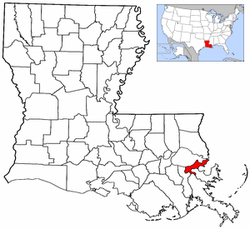History
Emergency medical transportation began in the city of New Orleans with hospital-based horse-drawn ambulances in the early 1900s. [3] Charity Hospital was one of the first hospitals in the United States to provide emergency medical transportation. [3] The current EMS agency began in 1947 as the EMS division within the New Orleans Police Department. These ambulances were referred to as "Crash Trucks", as they mainly responded to traffic collisions. [3] The ambulances were staffed with emergency medical technicians beginning in the 1960s, and the first paramedics started in 1979. [3]
On July 1, 1985, the EMS division was transferred from the police department to the New Orleans Health Department. [3] After Hurricane Katrina, the management of New Orleans EMS was changed to the New Orleans Office of Homeland Security and Emergency Preparedness. [3] The department still resides within the health department financially, but the Office of Homeland Security and Emergency Preparedness provides administrative oversight. [3]
Fleet
New Orleans EMS operates a fleet of Braun Liberty ambulances with Ford Super Duty cabs, painted white with two black stripes on the side. The rear of each ambulance has black-and-white reflective strips in the shape of large chevrons; some ambulances have these on their front bumpers as well. New Orleans EMS ambulances are equipped with a full Whelen Engineering Company emergency lighting system and are equipped with Whelen 295HFSC9 Dual Tone Sirens set to produce a simulated mechanical siren tone and regular electronic siren tone at the same time.
New Orleans EMS also operates a fleet of Chevrolet Tahoe SUVs used as nontransporting EMS vehicles, known as "Single Paramedic Rapid Intervention" or "Sprint" units. These vehicles, use a dark blue livery with a white stripe in the shape of a Z.
Special units
New Orleans EMS, as the sole provider of 911 emergency medical services in the City of New Orleans, is responsible for the provision of medical care at several major events every year. To adequately cover these special events and provide medical coverage to all areas of the city, New Orleans EMS relies on several types of highly specialized response vehicles (SRVs) and highly trained emergency medical technicians and paramedics. [9]
Bike Teams
The New Orleans EMS Bike Team consists of pairs of emergency medical technicians and paramedics who have taken the International Police Mountain Bike Association (IPMBA) course for Emergency Medical Services. The bike teams are utilized at outdoor festivals, music events, and extensively throughout the French Quarter. The bike teams carry an automated external defibrillator, cardiac monitoring equipment, and all the medications and supplies necessary for any medical or traumatic complaint.
Special Response Vehicles
New Orleans EMS operates three special response vehicles (SRVs) at various times. These vehicles consist of one modified John Deere Gator and two Alternative Support Apparatus (ASAP) Off-Road specialty vehicles. Both the Gator and the ASAP are used to extract sick or injured patients from areas with limited accessibility or large crowds. The Gator and ASAP are often used in parks, along parade routes, in the area around the Louisiana Superdome, and especially in the French Quarter where narrow streets and large crowds can make it difficult for full sized ambulances to maneuver. The SRVs are equipped with all the equipment found on a full-size ambulance and can transport a patient from the confined area to an aid station or transfer care to a waiting ambulance for transport to a hospital.
Emergency Medical Surge Unit
In February, 2010, New Orleans EMS acquired a medical ambulance bus (MAB) from Sartin Services, Inc. The MAB was named Emergency Medical Surge Unit (EMSU)-1 and has the capacity to transport 18 patients on stretchers and litters and 2 wheelchair patients, as well as six emergency medical technicians or paramedics. EMSU-1 was introduced to the public during the New Orleans Saints Super Bowl XLIV Championship Parade on February 9, 2010. [10] [11]
EMSU-1 saw extensive use as an on site treatment unit in support of the Rock 'n' Roll Mardi Gras Marathon, serving to greatly expand the ability and capacity of New Orleans EMS, and allowing on site delivery of acute medical care by emergency physicians and personnel.
The Community Outreach Program of New Orleans EMS is focused on "preventative health and safety education for the citizens of Orleans Parish". [12]
The Community Outreach Program teaches children safety and awareness through the T.A.S.K (Teaching Awareness and Safety to Kids) in child care centers, schools, and community centers. The Community Outreach Program is developing a program to target senior citizens and those with limited mobility and provide education and resources regarding environmental modification and fall prevention. Emergency medical technicians and paramedics with New Orleans EMS also mentor local students and teach public cardiopulmonary resuscitation and first aid classes.
This page is based on this
Wikipedia article Text is available under the
CC BY-SA 4.0 license; additional terms may apply.
Images, videos and audio are available under their respective licenses.







